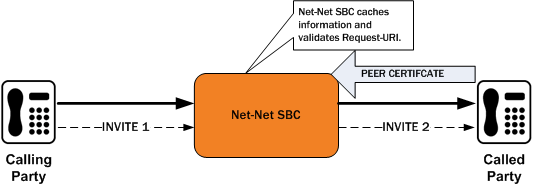Validating the Request-URI Based on Certificate Information
When you configure the Oracle Communications Session Border Controller to cache TLS certificate information to validate Request-URIs, it stores the Certificate Subject Name and Certificate Subject Alternative Name (only DNS) it learns from peer certificate attributes. It then takes these actions:
- Extracts the host from the Request-URI of the outgoing INVITE
- Compares this host (exact or wildcard match) with the Certificate Common Name or Certificate Subject Alternative name of the certificate it has received
- Sends out an INVITE if the Certificate Common Name or Certificate Subject Alternative name match; Sends a 403 Forbidden rejection to the endpoint from it received the INVITE if there is no match
Wildcard matching applies only to the prefix of the Request-URI:
*.acme.com *.*.acmepacket.com
This diagram shows a peering scenario where the Oracle Communications Session Border Controller receives an INVITE from the calling party, which it processes and prepares to send out INVITE 2. After establishing a TLS connection with the called party and caching the required information, the Oracle Communications Session Border Controller validates the Request-URI. Once validation occurs, the Oracle Communications Session Border Controller sends INVITE 2.

The peer certificate from the called party during the TLS handshake with the Oracle Communications Session Border Controller would look like this. Relevant information in the sample appears in bold font.
Certificate:
Data:
Version: 3 (0x2)
Serial Number: 9 (0x9)
Signature Algorithm: sha1WithRSAEncryption
Issuer: C=US, ST=MA, L=Woburn, O=Smith Securities, OU=Certificate Authority Dept, CN=Smith Certificate Authority/emailAddress=amith@CA.com
Validity
Not Before: Dec 10 21:14:56 2009 GMT
Not After : Jul 11 21:14:56 2019 GMT
Subject: C=US, ST=MA, L=Woburn, O=Acme Packet, OU=Certificate Authority Dept, CN=*.acme.com/emailAddress=ph2Server@acme.com
Subject Public Key Info:
Public Key Algorithm: rsaEncryption
RSA Public Key: (2048 bit)
X509v3 extensions:
X509v3 Basic Constraints:
CA:FALSE
X509v3 Issuer Alternative Name:
email:Smith@CA.com
X509v3 Subject Alternative Name:
DNS:gw1.acme.com, DNS:*.ano.com, DNS:*.some.com
X509v3 Key Usage: critical
Digital Signature, Key Encipherment
Signature Algorithm: sha1WithRSAEncryption
The outgoing SIP INVITE (INVITE 2 in the diagram) would then look like the sample below. The INVITE is sent because smith.acme.com matches the common name *.acme.com. Other valid SIP Request-URIs would be:
222222@gw1.acme.com 222222@smith.ano.com 222222@amith.some.com
You can see where the system uses information from the certificate; the text is bold.
INVITE sip:222222@smith.acme.com:5060 SIP/2.0
Via: SIP/2.0/UDP 172.16.27.113:5060;branch=z9hG4bK4jmg29cmm8l0cg7smmrn85o4q7
From: 111111 <sip:111111@acme.com>;tag=_ph1_tag
To: 222222 <sip:222222@acme.com>
Call-ID: _1-2_call_id-10147@acme.com-1-
CSeq: 1 INVITE
Contact: <sip:111111@172.16.27.113:5060;transport=udp>
Max-Forwards: 69
Subject: TBD
Content-Type: application/sdp
Content-Length: 138
Route: <sip:222222@172.16.27.188:5060;lr>
v=0
o=user1 53655765 2353687637 IN IP4 172.16.27.113
s=-
c=IN IP4 172.16.27.113
t=0 0
m=audio 20000 RTP/AVP 0
a=rtpmap:0 PCMU/8000



